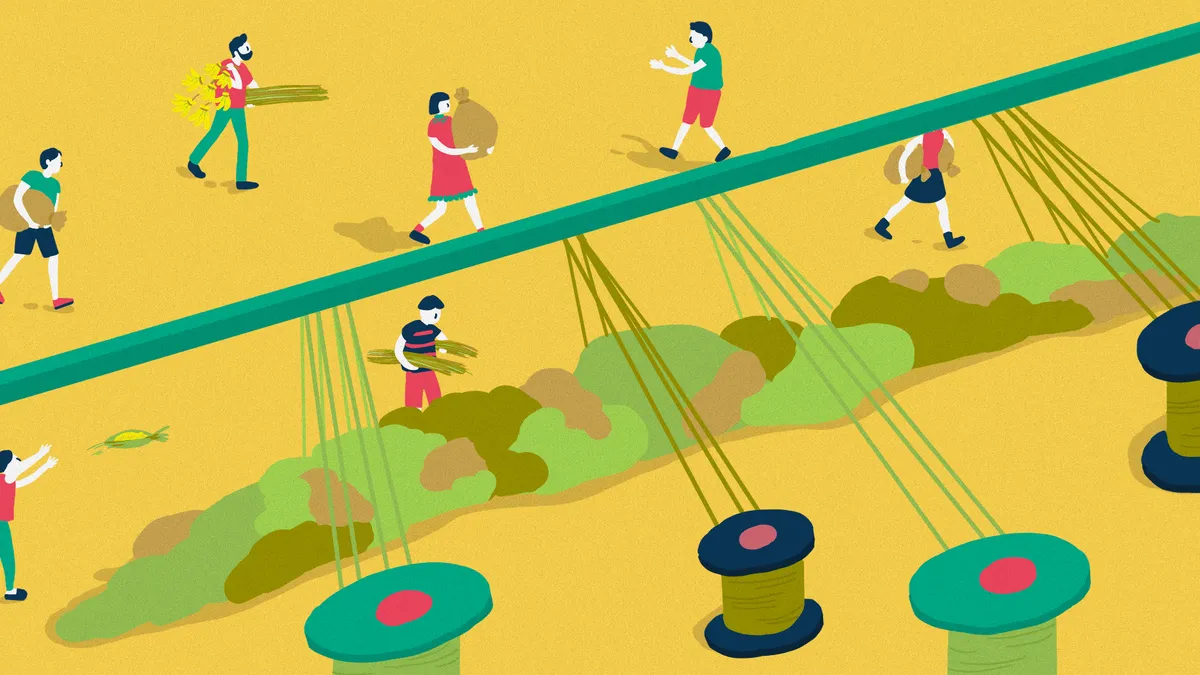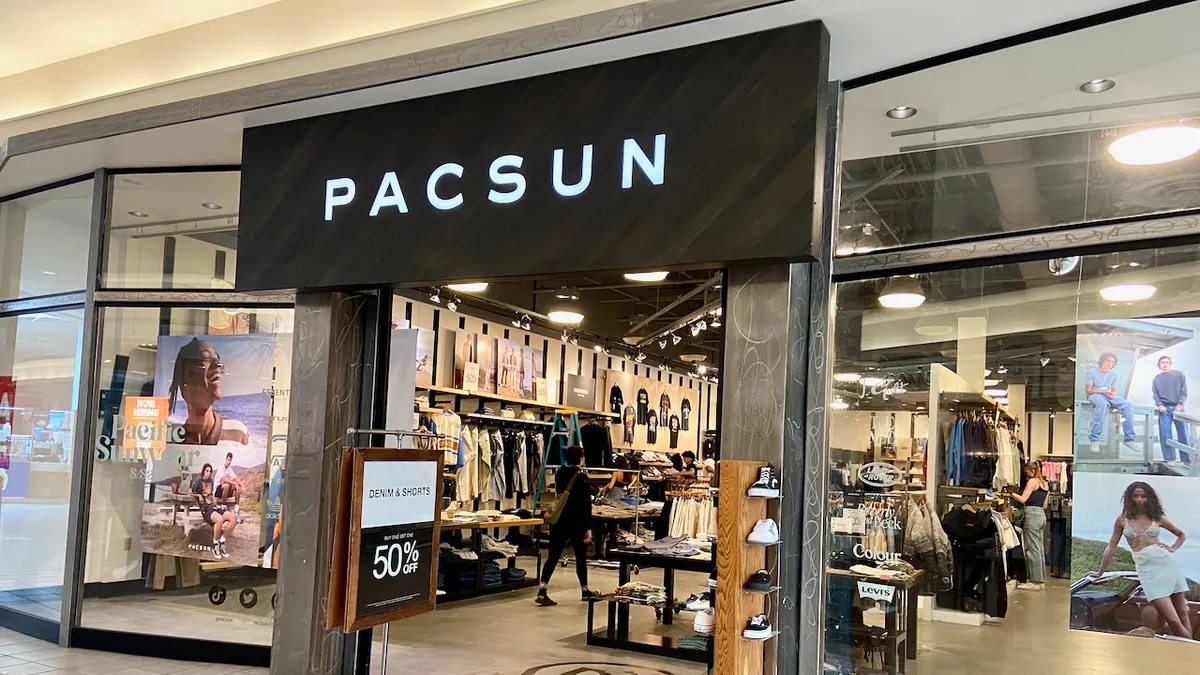This article is part of our series "From mushroom to handbag: Creating a closed loop textile supply chain." Click here to view all articles in the series.
Banana stalks. Pineapple leaves. Squeezed oranges. Mushroom roots. Corn. Spoiled milk. Wood pulp. Soy beans. Chicken feathers. Things that go to the dump? Not so fast. These are the raw materials for new textile fibers, and they’re changing not only the sustainability footprint of fabric production, but the supply chain as well.
Each year the world produces more than 100 million tons of fiber, and manmade fibers have increased from 14 million tons in 1980 to 71 million tons in 2016. "We produce them in environmentally problematic ways, because if we use petrol from beginning to end, that’s bad for the environment. There's not enough natural resources to supply those materials," Yiqi Yang, PhD, a professor at the University of Nebraska-Lincoln, told Supply Chain Dive.
Development takes time, and the world can’t wait for a major disaster to start developing them. "That’s why the world needs alternative fibers, to make them more eco-friendly and sustainable," said Yang, who teaches courses in textiles, merchandising and fashion design, as well as biological systems engineering.
The EPA estimates that in 2015, 11.94 million tons of clothing and footwear was produced, a steady increase from 1.36 million in 1960, and 6.47 million tons in 2000. Landfill use increased as well, as 8.24 million tons of these materials were tossed in 2015. That includes mostly textiles, rubber and leather. Another 1.35 million tons of sheets and towels were generated in 2015.
As a result, businesses are mining waste products for fiber production. They’re fermenting agricultural components not used for human consumption. And they’re taking scraps of material, which were formerly incinerated, and weaving new yarns. The developers are driven by a sense of purpose, but they’re also fashion insiders.
The alternative materials impact many parts of the supply chain, including sourcing, manufacturing and operations. Manufacturing sometimes has to be optimized for the new fibers. Buyers must understand the fibers’ properties, alone or in combination with others. There’s a lot of education involved at each level, and that’s not that easy when introducing a new material.
Alternative fibers now on the market
Qmilk: Don’t cry over 2 million tons of spoiled milk in Germany. While her factory can process 500 tons a year at full production, founder Anke Domaske is turning farmers’ unsold milk into Qmilk fabric ("q" for quality).
In 2011, Anke experimented by drying out spoiled milk and reconstituting it into dough, with additives to make it waterproof, but no chemicals. She extruded it into fibers thinner than hair. "You can eat the fiber. It’s that natural," she told Supply Chain Dive.
As an added benefit, its natural anti-microbial properties make it good for medical use, and fabric woven with Qmilk fibers was comfortable for her father, who developed a textile allergy when undergoing chemotherapy for leukemia.
Qmilk went into production in 2015, and the nonwoven textile is now in Italy’s Tenderly facial and toilet tissue. The apparel cycle takes longer, at least two years from development to the sales floor, and Qmilk’s fibers will be in a German outdoor manufacturer’s collections soon.
Factories and supply chains don’t need much adaptation to use Qmilk fibers, as they’re a protein fiber similar to wool and silk, said Domaske. The cost is more than cotton or viscose fibers, but less than wool, especially Merino wool. While Domaske is not ready to expand yet, she points out that there’s plenty of raw material in every country. "There’s a lot of milk turning sour," she said.
Orange Fiber: Rounding out the breakfast drink theme, the Italian company Orange Fiber uses orange juice byproducts to extract cellulose, getting a spinnable silky polymer which can be used alone or blended with other materials. The company said Italy tosses 700,000 tons of citrus byproduct annually after industrial juicing. Orange Fiber was founded in 2014, and Salvatore Ferragamo used the fabric in a 2017 collection.
Spider silk: Several companies are creating their own version of silk fashioned after the strong arachnid’s web thread, without enlisting a spider army of weavers. Bolt Threads out of Emeryville, California, formed in 2009. They ferment sugar, water, salts and yeast to make the thread. They raised $213 million from investors and are working with Patagonia to use the threads in their products. Last year, they rolled out knit tie protoypes, followed by hats.
Japanese company Spiber formed in 2008, making synthetic proteins also using a fermentation process. In 2015, they unveiled a North Face parka, followed by a Lexus seat concept using spider silk protein material which looks like plastic.
Mylo: Bolt Threads’ more recent undertaking is a collaboration with Ecovative, growing faux animal leather from mycelium, mushrooms’ underground root structure. They grow the cells with other nutrients in corn stalk beds, compressing the structure into a two-dimensional material, then tanning it with English Breakfast tea instead of caustic chemicals. It takes 10 days to grow Mylo, unlike the years it takes to raise a cow. The leather-like slab is cut into thinner pieces, giving a supple feel. The material is biodegradable.
Bolt Threads partnered with Stella McCartney on a handbag for a Victoria & Albert London exhibition, "Fashioned from Nature" and plans to sell the bags.
Piñatex: Pineapple leaves have great fiber and are also being turned into faux leather. The company said that pineapple plantations take up 10% of agricultural land in the Philippines, so the textile helps reuse some of the refuse. Hugo Boss uses Piñatex fabric to make some sneakers, and the Victoria & Albert exhibit features that as well. Piñatex is commercially available and next year, H&M will introduce the material into a collection.
As for sustainability, the company said it doesn’t use any chemicals on the Cradle2Cradle list of banned substances. It’s priced about the same as mid-range leather and is biodegradable. While the fiber is extracted in the Philippines, it’s then sent to Barcelona, Spain for finishing, and the company headquarters are in London, England.
Chicken feathers: Still in the academic research stage, Yang’s lab is trying to make protein fibers out of chicken feathers. The structure is the same as wool, he said. "There’s no reason they cannot be used for textile fibers. They’re fibrous. They’re coats for chickens." He’s already made some fibers and is working to improve its properties.
Chicken feathers used to be ground into powder for chicken feed, but that was prohibited after the onset of the avian flu. Chicken feathers are currently thrown away.
The future of sustainable textile businesses
The new materials aren’t necessarily a replacement for cotton, wool and polyester. "We’re a supplement to the market," Domaske said. The population is rising. People are buying more clothes, and more fibers are being used.
"There’s a lot of good stuff going on with all sorts of raw materials," said Eamonn Tighe, business development manager for NatureWorks, which produces textiles from corn sugar under the Ingeo label. "To be really credible, you’ve got to figure out a way to produce these materials in sizes of tons and be able to do it the same time every time, to be able to build the supply chain. That’s not easy," he told Supply Chain Dive.
Sustainability takes many forms, including material sourcing, processing materials and the manufacturing and transportation carbon footprint. These companies add income to the farms supplying their raw materials, even if the materials would otherwise go to the landfill. "It’s a very important resource. We want to pay for it," said Domaske of the spoiled milk.
But it’s also important that the business is sustainable, "not just from a carbon dioxide point of view, but that we’re making money, that our salaries can be paid, that we can reinvest. That is a heck of a challenge," said Tighe.






















